De todos los tiempos posibles de estar despierta y con ganas de reflexionar en mi vida escojo ahora, 3:40 de la mañana en una lunes con mi 10AM clase de cuatro horas colgada en la futura temprano. Probablemente era la mitad de bolsa de maíz inflado que tuve en mi cuarto que tiene la culpa de mantenerme despierta en esta hora, sussurándome a comer y escribir mis pensamientos. A veces no puedo explicar las cosas que pasan en Argentina, aún (especialmente) mis propios acciones. Pero adelante.
Cuando vi fotos de piedras preciosas en el libro de geología el semestre pasado mientras sentado en una biblioteca silenciosa dentro mi universidad en el nubloso estado de Ohio en los Estados Unidos, no tuve ningún idea que tendría la oportunidad de ver en la vida real una combinación de colores tan bellísima dentro de una montaña que ningún cámara ni libro de texto de geología pueda capturar. Con un grupo de treinta estudiantes y coordinadores, visité a los pueblos de Tilcara, Salinas, Purmamarca y Humahuaca en solo dos días.
Nos quedamos y comimos en una hostería diez minutos caminando del centro de Tilcara por tres noches. Visitamos a un sitio arqueológico de una parte de Tilcara con tumbas, casas, y espacios comunitarios reconstruidos en un diseño apenas exacto a la realidad del pasado, con estructuras elaboradas llamando más atención a la ingenuidad de los arqueológicos que una preservación auténtica de la tierra como realmente era.
Nuestra guia nos dijo que la disciplina de arqueología ha cambiado mucho en las últimas décadas en la manera de abordar la intervención de la naturaleza y investigación de historia con la participación y consentimiento de comunidades locales. Había una abundancia de oportunidades de comprar productos artesanales hecho en Jujuy, tal como chompas de alpaca y llama, manteles y tapices tejidos, y varias cosas lindas de cerámica y madera (especialmente un tipo se llama palo santo, que es verde y bonito– compré un mate (gourd) de esta material).
Otras actividades notables eran una lección en danza folklórica con una de nuestras coordinadores, una parada en Salinas (un paisaje único que parece cómo ) una visita a una peña con músicos locales en Tilcara. Volví a la ciudad anhelando más pureza del campo, en estado de shock sobre la belleza que había visto, y con el sentido de que había sido embromado con la tentación de conocer mucho más sobre este país en qué vivo por un periodo que ahora me parece tan chico.
La vida continua, y por suerte tengo un blog para compartir con otros este regalo que recibí en mi viaje de la velocidad a Jujuy. Si puedes, o lector por ahí, vaya a Jujuy antes de morirte. No vas a perder.
English now………..
The next topic that I wan to cover, briefly, so I don’t drag this post on for another week (!) is that of running, and the appreciation it brings for public parks and my time here in general. I’m finding that reserving at least half an hour each day to just move– whether it is biking, jogging, improvising in my expresión corporal class, or walking a long distance, is absolutely invaluable, and essential to both happiness and productivity. I speak as if this were a revelation that humanity had not already figured out, but each period in my life in which I find the scheduling rhythm to practice this lifestyle of physical exertion and expression each and every day is marked with a deeper level of understanding about what matters in life, and how to deal with the obligations and choices we face every day. Parque Centenario, a 10-minute jog from my apartment, is a delight. Each time I go, the vibe is different. On Sunday nights, it is HOPPING. Swing dancing, drum circles, outdoor contact improv jams, free outdoor movies and live performances, an abundance of lovestruck couples and entire families drinking maté at all hours of the evening, I have seen it all. Last Tuesday- free yoga, delicious sunshine and the newly present bite of autumn wind facilitating humble reflection and a desire to keep moving; Sunday, live jazz from hip young men and colorful scarves everywhere, countless couples out for a stroll.
Today (Saturday, approximately a week after I started writing this post) my friend Keren and I went to the “Feria del Productor a Consumidor” (basically a farmer’s and craft market) at Facultad de la Agronomía de la Universidad de Buenos Aires (environmental/agrarian division of the public university here). With the exception of spanish and the ubiquitous mate, I could very easily have been in Oberlin, Northampton, or another small progressive liberal arts college town (to my delight). An abundance of wide open sky, a huge garden, sheep cheese, a free African dance class, not a single colectivo in sight, and buena onda (good vibes) were just what I needed to recharge after a week of midterm exams (a.k.a. sitting in front of a computer screen for hours and sleeping not enough). Most importantly, Keren and I ran into friends we had met at a magical house in Belgrano with a backyard filled with overgrown trees, organic treats, silk-screening and sustainable lifestyle workshops and an empty pool used to house a band and dancers, a few weeks back. We had been discussing how much we wanted to return to this delightful space earlier today, and we were lucky enough to reconnect with the residents of this house in a space of a similar vibe. Slowly but surely I am finding the people and places that remind me of the parts of home and college life I am fondest of.
Finally, I would like to reveal that I just received notice that I received a grant from my college to extend my stay in Buenos Aires by a month to execute an internship-investigative project having to do with building communities through the arts, incorporating the knowledge I am gaining here about Argentina’s literary and cultural heritage (quite the fascinating and still vibrant one). I am currently enrolled in a class through the arts university (Universidad Nacional de las Artes) called Danza Comunitaria, which allows me to take part in a dance troupe called Bailarinas Toda la Vida and participate in a two-hour theory-based lecture/discussion class before rehearsal. The group is open to people of all ages, abilities, body types, and scheduling capacities (meaning the group of bodies present at each rehearsal is always shifting) manages to present works that are choreographed with enough individual leeway such that a fluctuant ensemble make-up doesn’t preclude performing their forever-in-progress works, which tend to have political, narrative and emotional themes having to do with Argentina’s painful history and complicated social present, which they feel as artists a responsibility to address and engage. Rehearsals take place on the second floor of a breadstick factory, recuperated after the 2001 economic crisis as a cooperative. Our discussions about capitalism, movement therapy, sensorial perception and body politics in the theoretical section of the course include the deeply enticing smell of breadsticks, maté, opinionated men and women from age 20 to 70 , and the director, Aurelia Chillemi, whose wonderfully humble but persistent logic about the link between public health, corporal expression and the community guides the intellectual and physical investigation that takes place each friday afternoon.

Boxes of breadsticks on the way upstairs to the dance studio at the Grissinopoli Breadstick Factory in Chacarita
The thing I love about this class is that the theory and the practice are right there next to each other; the comfortable academic distance easily taken in discussions about social justice and generating creative material doesn’t have time or space to exist, and demands that as a student (despite the language and cultural barriers that I could easily use as an excuse to remain an observer or a passive participant), I take the food for thought I hesitantly munch on during the theoretical class as a foreigner afraid she’s an impostor, with me upstairs. I must process and apply this knowledge in my mind and body when class ends and rehearsal starts, and even when I’m unsure of my purpose or role in the rehearsal space, I almost always find solace in reality that corporal and musical languages are universal, and that I am immediately roped into the web of connections in the space simply through dance.
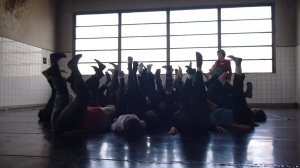
Bailarines Toda la Vida. (Not a picture I took…found it on the internet but it accurately represents a characteristic tableau in the rehearsal space).
My hope for my extra time in Argentina is to continue participating in the group at the very least, while writing about it, interviewing members, and potentially collaborating as an artistic leader further along in the semester on a project relevant to my literary/cultural studies (and hopefully teaching English on the side to fill in my lack of academic structure/need for supplemental income). There are so many organizations in the city working toward using the performing arts — circus, dance, theater, folkloric traditions, and more — as a means to rebuilding communities who experience social, physical or economic disadvantages in society, and I intend to seek work as a volunteer for at least one of them in addition or in place of the aforementioned project.
I pause, here, to finish making my homemade peanut butter, and get on with my Saturday night. I have to prepare to romper la noche, as my host-dad fondly dubs the process of spending a night on the town in Buenos Aires. After dancing for two hours straight to a Brazilian band at an “afrobeat” festival last weekend and enjoying it thoroughly, I feel the urge to go out in search of another pleasant surprise in this city pulsing with dancers, musicians and thinkers out for a good time.
Hasta la próxima entrada….
BECCA
P.S. I survived my first week of exams in Buenos Aires!! Hallelujah!

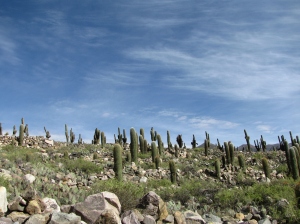
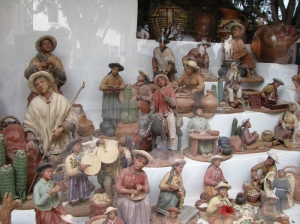
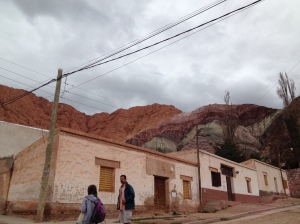
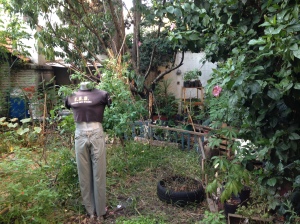

As I read your words, I see color, bright colors. All sound exactly what you wanted.
BUT…..when do yoi have time to sleep.
Keep your words coming.
Love
LikeLike